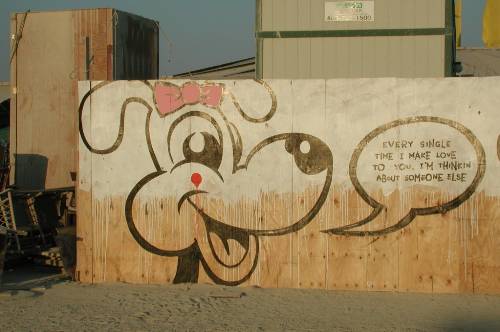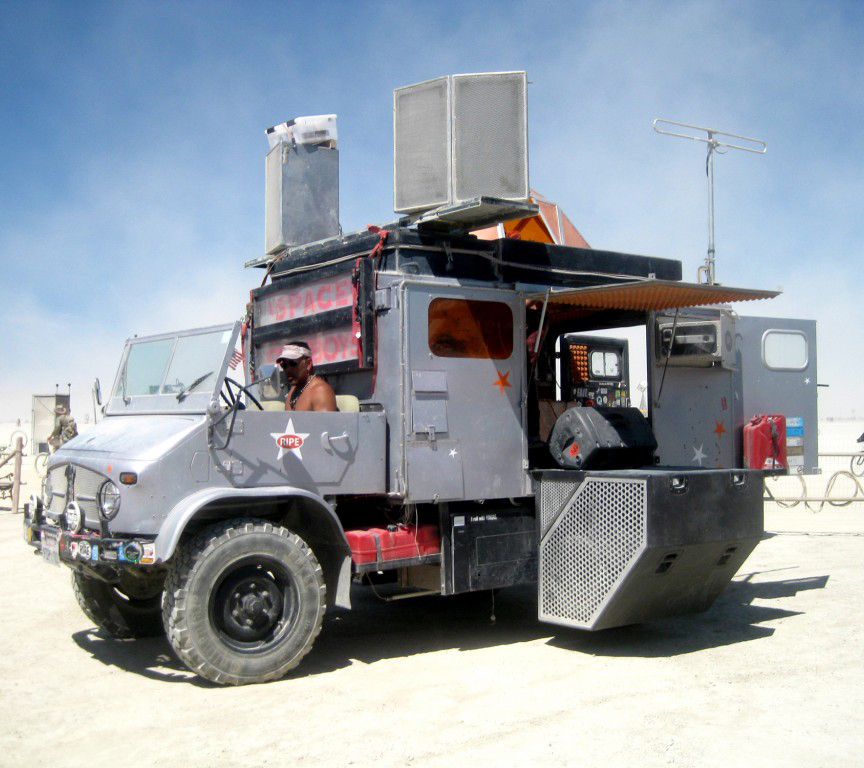
- Body: Blue outline and Green inside
- Face: Green and purple neon with Blue top of head
- First year the Man is hoisted up by crane
- The Temple of Wisdom (popularly referred to as "the big A") was our first effort at a construction to elevate the Man. The four legs provided ladder access and egress to a room at the top with commanding views down the Promenades.


One of the murals on the back wall of the Cafe, by British graffitti artist Banksy


Our theme in 2001 takes the form of an enormous board game. The object of this game is the attainment of wisdom. In order to achieve this goal, participants must pass through successive stages of life. The theme of our game is choice, striving, trial and transformation. Ranged outward from the center of our city on an axis called the Promenade, these Seven Ages of Man will consist of the Cradle, the Playground, the Chapel, the Coliseum, the Temple of Wisdom, the Maze, and the Mausoleum. Participants will be issued passports to guide them on this journey. At each station, they’ll be offered the opportunity to undergo a life experience. Lessons in life must be achieved. Hence, to progress toward their ultimate goal, participants must undertake actions. ... Having completed six stages of this course (in any order), participants will be eligible to undergo a final initiation that will lead them inward and upward through the Temple of Wisdom. 2001 Art Theme: The Seven Ages

Unimog
In 2001, the long-standing San Francisco art and music collective, Space Cowboys, transformed their unique vision of a futuristic All-Terrain Audio/Visual Assault Vehicle into a reality. They purchased an imported Unimog, and quickly began the lengthy process of modification. ... the Space Cowboys completed their project just in time for the intended grand unveiling at the 2001 Burning Man event. Pumping 10,000 watts of sound, a complex array of video and light projectors and a fully enclosed DJ dome, the Space Cowboy rolled through Black Rock City on it’s maiden voyage, immediately attracting crowds numbering in the thousands.
Space Cowboys
The Life of Art
The immediate aim of this non-profit foundation will be to support the work of artists within the Burning Man community. Contributions will be used to aid our artist-citizens in a variety of ways. It will be the mission of the Foundation to furnish artists with direct financial aid for the production and display of interactive art works. Particular attention will be given to artists whose careers exist beyond the institutional mainstream. The initial focus of this effort will be on art that is produced to be displayed in Black Rock City, but the scope of the Foundation's mission, like our own, will exceed the Burning Man event.
"It is the mission of the Black Rock Arts Foundation to promote a revival of art's culture-bearing and connective function by removing art from its context in the marketplace and reintegrating it into communal settings. In many cases, this will be art that is designed to be touched, handled, played with, and moved through in a public arena. It is art that solicits a collaborative response from its audience, even as it encourages collaboration between artists. It deliberately blurs the distinction between audience and art form, professional and amateur, spectator and participant. It is art that's generated by a way of life, and it seeks, in its broadest aims, to reclaim the realms of politics, nature, history, ritual and myth for the practice of art."

The Man himself was the ultimate destination in the game, being placed upon the tower of enlightenment. The tower was a structure that participants could ascend once they had achieved passage through the other six stages of life, and it added an additional 30 feet to the height of the man.
From this vantage-point, participants had a unique viewpoint of all of Black Rock City. This year our community had been educated ahead of time about their rights and responsibilities, and responded in their usual conscientious manner.
2001 was also the first year of the Afterburn Report to supplement information passed to the community in the Winter Town Hall meetings and has served as a perfect vehicle for recording the History of Burning Man.
Read more in the 2001 Event Archive
- Theme: Seven Ages
- The Gate staff had a new problem this year: counterfeit tickets. They caught an estimated 99% of the counterfeit tickets and assisted the box office in the collection of information about the perpetrators from distraught and angered participants who still had to buy full-price tickets.
- During the event, the portable toilets (long a scandal among participants) remained clean, and, when everyone departed, exodus was smooth and we had to clean up far fewer burn scars and trash.
- After selling 6 truckloads of ice in 1999 and 7 truckloads in 2000, in 2001 the CampArctica staff distributed 13 45' semi trucks loaded with ice.
- In addition to the normal work building Black Rock City, DPW launched an ambitious plan to develop a better base of operations. Those operations are centered at the Work Ranch - the bone yard formerly known as 80 acres - a leased property located in Hualapai Valley about 13 miles from the present location of Black Rock City. At the peak of the work season in August over 200 DPW workers inhabit the Work Ranch.
- For the first time every artwork was marked with GPS (global positioning station) waypoints, which facilitated tracking of placement and cleanup.
- Asylum, the first New York based Village is organized with over 250 participants seven theme camps and a 48 foot truck container that was hauled from New York City to Black Rock City and back!
- Upgrades in the already fabulous Center Camp Café distribute 70,000 beverages over the course of the week - a 40% increase over 2000 - with very few lines until exhaustion overtook the shift schedules post-Burn.
- One of the warmer, drier events on record. Lack of rain in the winter and spring lead to a more crusty, powdery playa than in previous. Thin tire bikes were almost useless in the powder.
- There were approximately 220 registered media for 2001, down slightly from the estimated 250 in 2000. Largest decrease was in the webzines, many of which Dot-bombed between BM2000 and BM2001.
- The international media began discovering Burning Man. About 30 percent of the registered media in 2001 were international.
- The Media team is spending an increasing amount of time doing more copyright protection work of Burning Man images - getting auctions pulled from eBay, telling people they can't associate products with the Burning Man name. There is also a heightened sensitivity about the rights of individuals when it comes to being photographed. This is extending to the regional events as well, which are working with Media Mecca to establish their own camera policies.
- Inspection of the site in spring of 2002 revealed the best clean-up effort yet! We passed the inspection with flying colors, and thank all of you for your outstanding efforts to leave no trace!

2001 saw Burning Man's first foray into "web-logging"
For a period of two months, Danger Ranger piloted a 30-year-old RV across 15 states, stopping at numerous cities, towns and places along the way with a mission to spread the Burning Man ethos and furnish people with information that could help them reconvene their Burning Man experience year-round. Burning Man is not an event, but a new way of doing and being wherever you are. All the while he wrote and uploaded pictures of his travels in the Silver Seed Tour.
The Silver Seed Tour of America was a new exploration. It was the first time that an ambassador of Black Rock City traveled the country with the express purpose of making a personal connection with members of our community.

Randal Alan Smith lived with the DPW and wrote one of (if not the first) blogs that recorded the camaraderie and hard work of Burning Man's Department of Public works in his Feeding Tofu To Cowboys (reports from the DPW fray during setup).

Perhaps more than any other installation, David Best and Jack Haye's Mausoleum (also known as the Temple of Tears) combined the aims of art and life. During the event, its several altars were heaped with contributions, mementos, and tributes to the dead, and participants covered its walls with inscriptions.
Upon entering, one immediately noticed the silence and focused attention of the crowd constantly gathered here. This grand and eloquent monument to the departed moved many people to tears. Was this installation art or was it life? For the thousands who witnessed the immolation of the Mausoleum on Sunday night, it was both.

I've been asked to comment on the Jiffy Lube incident that occurred at Burning Man this year....As everyone knows by now, this year Jiffy Lube chose to erect a 12-foot tall sign in front of their camp portraying two men engaged in anal intercourse. Did a twelve foot tall pornographic sign violate the standards of Black Rock City? Probably not. Neither Ms. Pike nor our Rangers have been able to find anyone who is willing to step forward and admit that they made a complaint. Even if an individual did complain to Sheriff's deputies, I sincerely doubt anything resembling a "prevailing" standard could be deduced from this. ... the Jiffy Lube affair does not represent any sort of sinister homophobic agenda, nor is it an instance of heavy-handed and heedless oppression. In Black Rock City, however, county authorities waited till Thursday, initially took "no" for an answer, and then asked the Black Rock Rangers to mediate the dispute. The Sheriff of the county and the district director of the BLM sat down with camp members, discussed the issue with them at length and then proposed a compromise that allowed a dissident faction, a minority within that camp, to publicly protest their decision! ... by coming to us with a willingness to engage in discussions, they've also showed a measure of respect for our community. In the aftermath of this affair, the offending sign was eventually returned to Jiffy Lube and stored within the confines of that camp. However, many questions have remained. Have human rights been trampled on? Does Burning Man condone homophobia? Is this a foot in the door, and will official censors now police the content of art at our event? The answer to all of these questions is a resounding "no". Larry Harvey, 2001 JRS extra

That year's stage roster included:
Fashion Show
Michael Olsen (Flamenco guitar)
The HipHop Lounge
Jeffery Stott (mideast percussion)










































